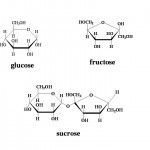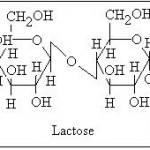There are several different types of sugars, all with various qualities and sweetness levels. Different sugars give different impressions of sweetness with sucrose being the longest to be detected on the tongue and the most lingering of the bunch. By comparison, fructose registers quickly and strongly but it also fades very quickly. But before we talk more about the complexities of sugars, lets define all of of them:
Glucose (aka Dextrose)
It is a simple sugar, the most common sugar from which living cells directly extract chemical energy. It can be found in many fruits and in honey but always in a mixture with other sugars. It is the building block from which starch chains are constructed.
Glucose is less sweet, less soluble in water and produces a thinner solution than table sugar. It also melts and begins to caramelize at around 300F/150C.
Fructose (aka Levulose)
It has the exact same chemical formula as glucose with the atoms being arranged in a different structure. Like glucose, it is found in fruits and honey.
Fructose is the sweetest of the common sugars, the most soluble in water and it absorbs and retains water the most effectively. However, our bodies metabolise fructose more slowly than glucose and sucrose so it causes a slower rise in blood glucose levels. It melts and caramelizes at around 220F/105C.
Sucrose (aka table sugar)
It is a composite molecule made from one molecule each of glucose and fructose. Green plants produce this compound in the process of photosynthesis and of all the common sugars it has the most useful combination of properties. It is the second sweetest but it is the only one have a pleasant taste even at very high concentrations.
Sucrose is also the second most soluble sugar and it produces the greatest viscosity in a water solution. It begins to melt around 320F/160C and caramelizes at around 340F/170C.
When heated in the presence of some acid or around certain enzymes, sucrose breaks apart into two subsugars. Breaking sucrose into glucose and fructose is often referred to as “inversion” and the resulting mixture is referred to as an invert sugar. Generally this syrup contains 75% glucose and fructose and 25% sucrose; and only exists in liquid form because the fructose component never fully crystallizes.
Lactose
It is the sugar found in milk products and a composite of two simple sugars, glucose and galactose. It is much less sweet than table sugar and used predominantly for sugar alcohols and its physical bulk than for its sweetness.

